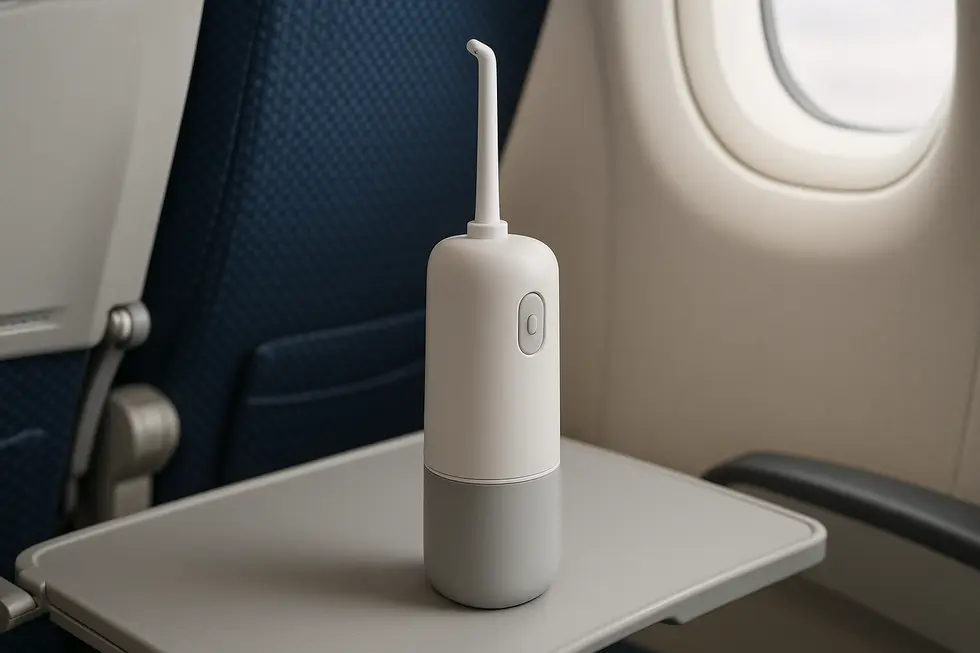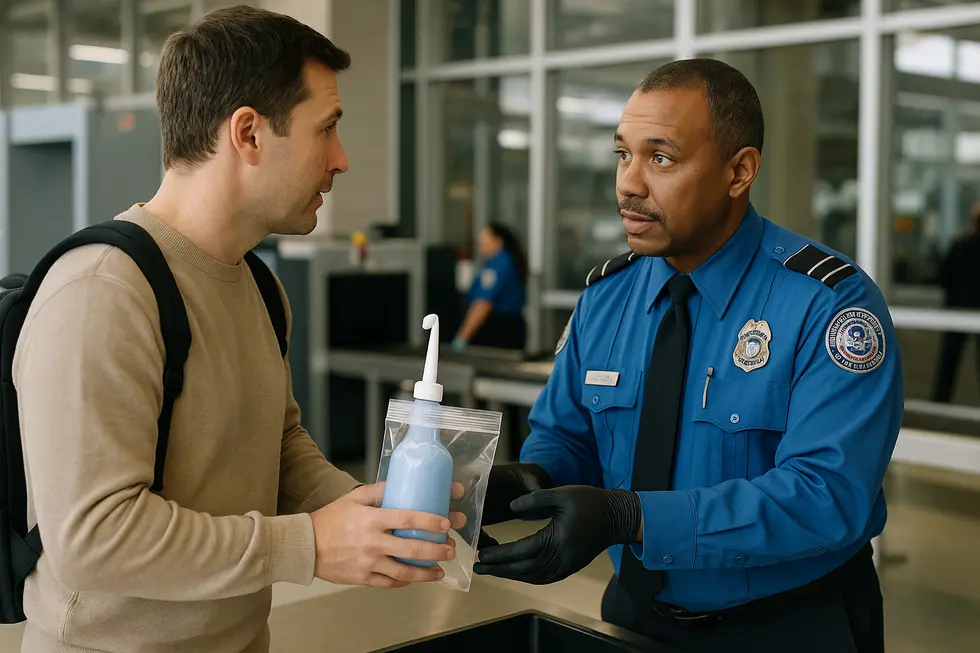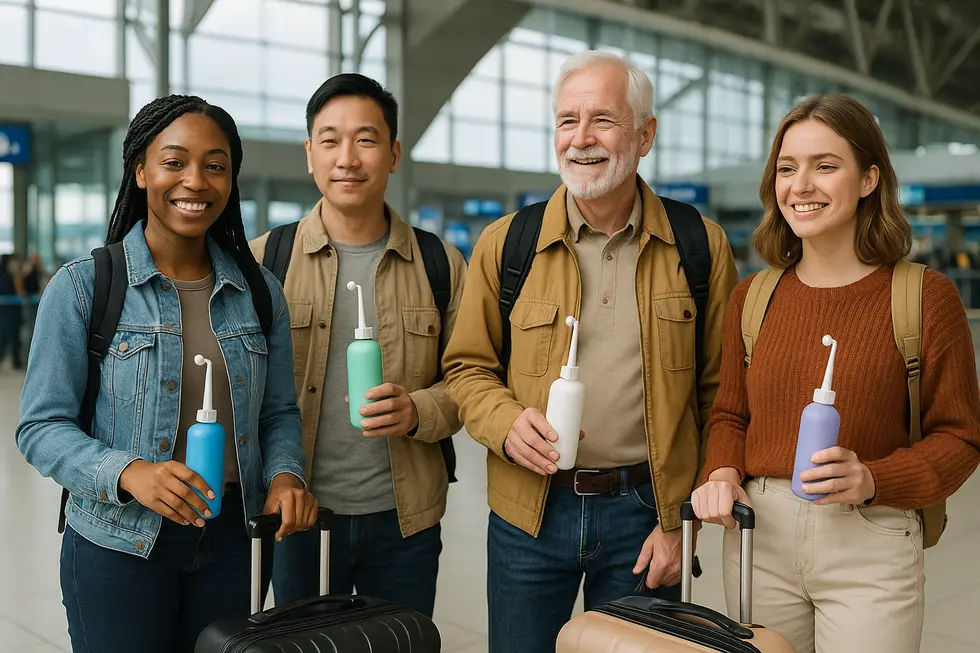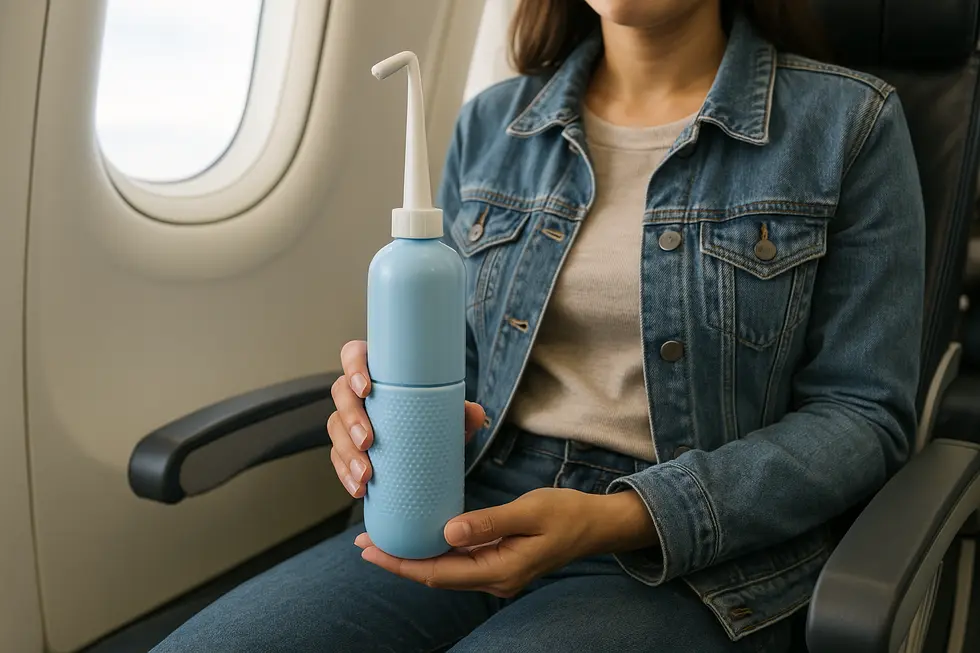Portable Bidet
Portable Bidets: Essential Travel Hygiene for Families on the Go
As air travel becomes more regular for families, ensuring hygiene on the go is crucial. A portable bidet for airplane use offers a compact, leak-proof solution designed for cramped airplane bathrooms. This guide explores how these devices work, their travel-friendly design, relevant regulations, and the rising demand among family travelers.
Engineered for the Skies: What Makes a Portable Bidet Truly Airplane-Ready

Sliding a portable bidet into a carry-on seems simple—until you remember the realities of airport security and the cramped aircraft lavatory. Designing a unit that performs reliably at 35,000 feet begins with sheer physics: every cubic centimetre and gram matters. A body under 150 g and a silhouette that slips into a jacket pocket help the device clear the volume occupied by your phone and inflight snack, while also dodging overweight baggage fees.
Size is only the first hurdle. International security rules cap onboard liquids at 100 ml, so most travel bidets employ a collapsible or refill-on-demand reservoir. Good engineers shape the tank with a low centre of gravity so it can perch on a tiny sink edge without tipping during turbulence. A silicone check valve then seals the nozzle path, preventing pressure shifts from forcing water into your bag mid-flight.
Spray comfort depends on pressure control. Manual squeeze bottles offer intuitive modulation—firm squeeze for a stronger jet, gentler pressure for sensitive skin—yet they still need an internal baffle or air-vent slot so the flow stops instantly when you release your grip. Battery-powered pumps add consistency but must remain low-decibel; nobody wants a mechanical whir advertising their visit to the lav.
Hygiene drives material choices. Medical-grade polymers resist microbial growth, and retracting tips shield the spray holes from splashes inside the lavatory. Some models integrate a micro-rinse channel that uses the final drops in the tank to flush the nozzle, echoing the principles discussed in our guide to self-cleaning nozzle design. Durable O-rings encircle every joint, preserving a watertight seal throughout pressure changes during ascent and descent.
Finally, discretion finishes the checklist. A neutral colour, a logo-free surface, and a pouch that resembles a sunglass case deflect curious glances at security. Keep the unit in an outer pocket, ready to display and explain if TSA asks. With these thoughtful specifications—compact form, leak protection, intuitive pressure, sterile surfaces, and quiet confidence—a portable bidet becomes not just travel-friendly but travel-proof. For a visual look at how minimal a pocket-ready design can be, see this example of a pocket-sized model.
Navigating TSA Checkpoints with a Portable Bidet: What Air Travelers Need to Know

Airports are stressful enough without wondering whether your portable bidet will be confiscated at security. Fortunately, most manual squeeze-style travel bidets sail through screening because they contain no prohibited parts. The only red flag is liquid. Empty the reservoir before you reach the queue, then stow it with the cap off so officers can instantly see it is dry. If you prefer to pre-fill, decant water into a container no larger than 3.4 oz and slip that bottle into your quart-sized bag with the rest of your toiletries to satisfy the 3-1-1 rule.
Electric or rechargeable models introduce a second layer of scrutiny: lithium batteries. The Transportation Security Administration permits lithium-ion cells rated under 100 Wh in carry-on baggage, but some airlines cap the number of spare batteries or ask that terminals be taped. Check the battery’s watt-hour rating—usually printed near the charging port—and review your carrier’s policy the night before departure. Detaching the battery, when possible, speeds up inspection because you can place it in a separate bin like a laptop.
Packing strategy matters. Position the bidet near the top of your bag so agents can reach it without burrowing through clothing. A transparent pouch prevents confusion, keeps the nozzle clean, and signals that the device is hygienic. If you are selected for secondary screening, a calm, concise description—“It’s a personal hygiene sprayer”—is usually all that is required. Many travelers even discover that agents are curious and appreciative of the environmentally friendly swap from paper.
International connections add another wrinkle: certain countries restrict water containers entering agricultural zones. Again, traveling dry is the simplest fix; you can fill up in the terminal restroom after customs. Before your return flight, give the bottle a quick wash with soap to avoid residual odor that might prompt additional checks.
For a broader look at choosing models designed specifically for mobility, this detailed travel bidet guide outlines weight, capacity, and nozzle options that pair well with aviation rules.
By combining an empty reservoir, battery awareness, and open communication, you can keep your cleanliness routine intact from takeoff to landing without a single TSA hiccup. (Source: https://www.the-express.com/travel/usa/174371/tsa-stop-me-airport-item)
Sky-High Hygiene: How Rising Demand Is Shaping the Portable Bidet Market for Frequent Flyers

Disposable wipes once ruled the cramped airplane lavatory, but a quiet revolution is underway. Travelers are discovering that a palm-sized spray bottle can deliver hotel-bathroom cleanliness without the bulk, and the market is responding in kind. Analysts tracking personal-care accessories report that portable bidets now make up one of the fastest-growing niches within the broader bidet category, mirroring forecasts that place overall bidet sales on a steady 6–7 % annual climb through the next decade.
Demand is driven by three overlapping forces. First, hygiene consciousness has intensified since global health disruptions; flyers want a solution that goes beyond a thin sheet of airline tissue. Second, environmental awareness is rising: a reusable jet of water replaces packets of single-use wipes that clog waste systems and increase cabin trash weight. Third, comfort expectations have shifted. Long-haul passengers, postpartum parents, and travelers with limited mobility value a tool that turns a five-square-foot lavatory into a functional washroom.
Manufacturers have answered with feather-light squeeze bottles and USB-rechargeable sprayers that tuck into a shirt pocket. These designs stay under the Transportation Security Administration’s 3.4-ounce liquid rule when empty, while silicone bellows collapse flat to slide beside a phone in a seat-back pouch. To avoid delays at security, seasoned flyers detach nozzles, keep reservoirs dry, and place the device atop other toiletries; a quick explanation usually satisfies curious officers.
Retail data show that portability trumps every other specification. Flyers consistently choose units under six ounces even when higher-capacity models advertise stronger pressure. Adjustable spray patterns and angled nozzles follow close behind, because an airplane lavatory demands precision rather than sheer volume. Online reviews echo this priority hierarchy, with ergonomic grip and discreet carrying cases mentioned more often than price.
The trend has also spurred informational resources. Blogs devoted to sustainable travel hygiene, such as this guide on portable bidets for travel, help newcomers compare materials, maintenance, and nozzle lengths before boarding day.
Looking ahead, industry insiders predict sleeker electric pumps, antimicrobial coatings, and even connectivity that tracks water usage to quantify each passenger’s environmental savings. For a glimpse at what the next generation already looks like, see this detailed review of a fold-flat travel model: https://www.travelandleisure.com/tushy-portable-bidet-review-11734784
Final thoughts
In conclusion, portable bidets are transforming how families experience air travel, offering a convenient and hygienic solution to airplane bathroom limitations. Understanding their design, ensuring TSA compliance, and acknowledging market trends allow travelers to make informed choices. As this industry grows, it provides exciting possibilities for enhancing travel comfort and hygiene for families worldwide.
Experience a new standard of clean with PEGABidet—designed for comfort, safety, and independence. Join thousands who trust us to make personal care simple and dignified. Contact us contact@pegabidet.com
About us
PEGABidet is a brand owned by L.A NEXTGEN LLC, based in California. We design intuitive, hygienic, and accessible bathroom solutions that prioritize safety, dignity, and independence. Our mission is to make personal care effortless and empowering for people at every stage of life.

